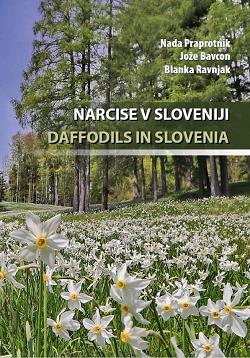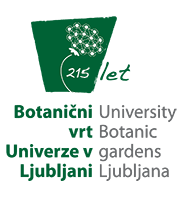“In recent years, I have made it a habit to visit on the Feast of Corpus Christi ... Despite the nice, warm weather of early summer, it seemed as fresh snow had fallen, as the green slopes looked as if covered by sugar ... Multitudes of white daffodils covered all the mountain meadows, daffodils so beautiful and so abundant that I have never, no where, seen a flower be as predominant to such an extent. Daffodils as far as the eye could see, daffodils everywhere ... I was climbing a true-to-life daffodil mountain. I walked through the white daffodil gardens to the top of Golica every Feast of Corpus Christi, year after year, as if on a pilgrimage to the altar of flowers. Filled with pious memories, I listened and gazed on the land of my fathers.”
Julius Kugy: The Life of a Mountaineer (1968)
Poet’s daffodil (Narcissus poeticus L. subsp. radiiflorus (Salisb.) Baker) is also known by other names: poet’s narcissus, nargis, pheasant’s eye and others. Academic Dr Milko Matičetov (1979) found around 120 local names for it. But daffodils do not grow only in Karavanks. They are just best known in Karavanks because of their abundance. They can be found in Karst, Slovenian Istria, Kočevsko, Prekmurje and other places. They are certainly most abundant in Karavanks above Jesenice, but they grow in other locations on grassy surfaces, pastures and meadows. With smaller density of populations, they are more accessible, as we can walk up to almost any flower, look and it, and compare the intraspecies diversity. On Golica and surrounding areas, this is often too difficult, as there are so many daffodils that you can not even walk among them. So we can only watch these countless populations from their edges, where the green is encroaching on them, and where we can still walk without trampling their precious white flowers.
The genus of daffodils is relatively large and includes about 26 species, while some authors list even more species – over 60. The taxonomy of daffodils is relatively complex due to the large number of garden varieties, natural hybrids and many years of cultivation resulting in numerous new combinations. Nevertheless, this is a genus with a typical Mediterranean distribution. Even though there are relatively few species in this particular genus compared to some other plant genera, it is the genus Narcissus that has a remarkable diversity in the species potential. However, in this relatively low number of species, gardeners and breeders found numerous cultivars, and then cultivated thousands more. Daffodils are one of the oldest and most beautiful spring bulbous plants, and one of the most prized garden plants for centuries.
Over 25,000 cultivars have been used in horticulture for several centuries. There are many common names for daffodils in Slovenia and throughout the world.
Text in Slovenian and English
ISBN: 978-961-6822-53-4
Number of pages: 218
Size: 17,2 x 24 cm
Price: 28 €





INDEX
RECENZION 1 ... 11
RECENZION 2 ... 13
FOREWORD ... 15
BOTANY ... 23
Introduction ... 23
Taxonomy of daffodils ... 25
Intersection hybrids ... 31
HISTORY OF DAFFODIL STUDY ... 33
Genus history ... 33
History of Narcissus poeticus group ... 43
History of daffodils in Slovenia ... 51
Daffodils in old herbarium collections ... 73
DAFFODILS IN SLOVENIA ... 79
Time of blooming ... 81
Ecology ... 85
Ecotypes and daffodils in Slovenia ... 95
Daffodil anomalies ... 99
Descriptions of new varieties ... 103
Nature-protection perspective ... 111
ETHNOBOTANY ... 121
Slovenian onomatology ... 123
Mythology and symbolism ... 135
Daffodils in Slovenian folklore ... 141
Golica ... 147
Daffodils in Slovenian literature ... 151
Daffodils in popular and hiking literature ... 155
DAFFODILS IN SLOVENIAN EVERYDAY LIFE ... 161
Daffodils in the Karavanks ... 161
Poet’s daffodil preservation efforts in Jesenice ... 167
Daffodils as symbols and products ... 171
Daffodils in eastern Slovenia ... 177
Daffodils in Karst and Slovenian Istria ... 183
Daffodils in Kočevsko ... 185
Daffodils of Lower Carniola ... 189
Daffodils in surrounding areas ... 191
Use of daffodils ... 193
ACKNOWLEDGEMENTS ... 197
REFERENCES ... 198
INDEX ... 206
INDEX IMAGES ... 209






